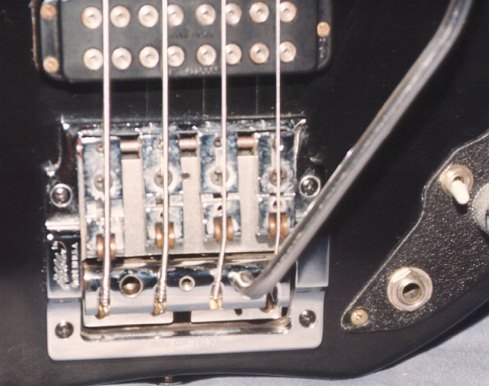
Copyright 1998, 20th Century Guitar Magazine.
I’m a bassist. Unlike guitarists who like tried and true designs, bass players are generally more accepting of innovative designs in bass guitars, amps and effects. Regardless of the typical bassist’s open-mindedness, one has to wonder why a bass guitarist would want a vibrato tailpiece mounted on his/her bass guitar.
So here we are face to face with two basses straight out of the mid-1980s when big hair metal was at its peak: a 1984 G&L Interceptor Bass and a 1985 Guild Pilot SB-602 Bass both equipped with a factory optional Kahler vibrato unit. These basses answer the rhetorical question, “If a heavy metal guitarist can have a whammy bar for dive bombing, why can’t a bassist have one, too?”
The G&L Interceptor Bass was introduced in 1984 and was discontinued in 1991. The example shown here has an ash body and maple neck with rosewood fingerboard. It is fitted with active/passive G&L Magnetic Field Design humbucking pickups. The preamp circuit and pickups were designed by none other than Leo Fender. The wacky, angular styling was probably not Leo’s idea and likely came from the marketing department which felt it would fit in better with the angular, metallistic guitars of the day.

The Guild Pilot SB-602 Bass was introduced in 1983 and was discontinued in 1993. The example shown here has a poplar body and maple neck with rosewood fingerboard. It is fitted with active EMG P-J style pickups. The Jazz Bass-inspired body shape is instantly recognizable and very comfortable. The smooth Voxy headstock shape compliments the body and the design hardly looks dated compared to the G&L.
These basses sound very good, but different from one another, however that’s not important since we’re exploring their whammiosity (vibratoness? tremolotivity?). Dive bombing, popular with guitarists, results in a low “thunk” when attempted with the Kahler-equipped Interceptor and Pilot. It’s sort of like plucking a taut rubber band and letting it go slack while it’s still vibrating… flump. However, the vibrato tail does work well for gentle, Chet Atkins-style vibrato and that’s the key for success. Using the wiggle stick in this manner imparts a low-intensity, but noticeable, vibrato to the note(s) being played.
The Kahler isn’t really useful or needed for traditional bar-band type rock. It could be a useful tool in the hands of a virtuoso bassist or a highly skilled bassist who steps out with lead lines from time to time. Maybe Michael Manring will use one for his next CD. Where I found the Kahler most useful was playing some surf tunes (really!) and playing some bass lines that I normally play on fretless bass. The whammy bar can be used to impart a vibrato similar to that done on fretless by rocking one’s hand (as done on all fretless stringed instruments such as violins). The G&L stayed in tune well after my test drive, but the Guild went out of tune a bit on two strings. A little graphite in the nut slot (or fresh strings) may be all that is needed to cure that glitch.

Then there’s the Kahler unit itself. After looking at the basses, the next questions that came to mind were “Is it a tone-robbing contraption?” and “Does it mechanically work well?” The answers may surprise you. First, it does not perceptibly rob tone. I compared the Interceptor Bass to a hard tail ‘84 G&L El Toro which is the same bass but with a more traditional body style. I really couldn’t hear much of a difference between the two. If anything, the Kahler equipped bass doesn’t sustain quite as much as a bass with a traditional type tail piece and bridge. The decent sustain is likely due to the Kahler’s massive casting. It’s quite the hunk of hardware. It is also highly adjustable for saddle height, intonation, and distance between strings.
So why does a bassist need a vibrato tailpiece? Beats me, but I wouldn’t pass up a bass with a Kahler unit just because it doesn’t conform to the norm. These two basses performed just fine and a player can opt out of using the whammy bar by simply not installing the trem arm when playing. Yes, it looks different but what the heck. Be a danger seeker. Be on the cutting edge. Be a whammy bassist.
About the author: Greg Gagliano is not a danger seeker and therefore does not use his whammy bass in public. Mr. Chicken may be contacted c/o TCG.